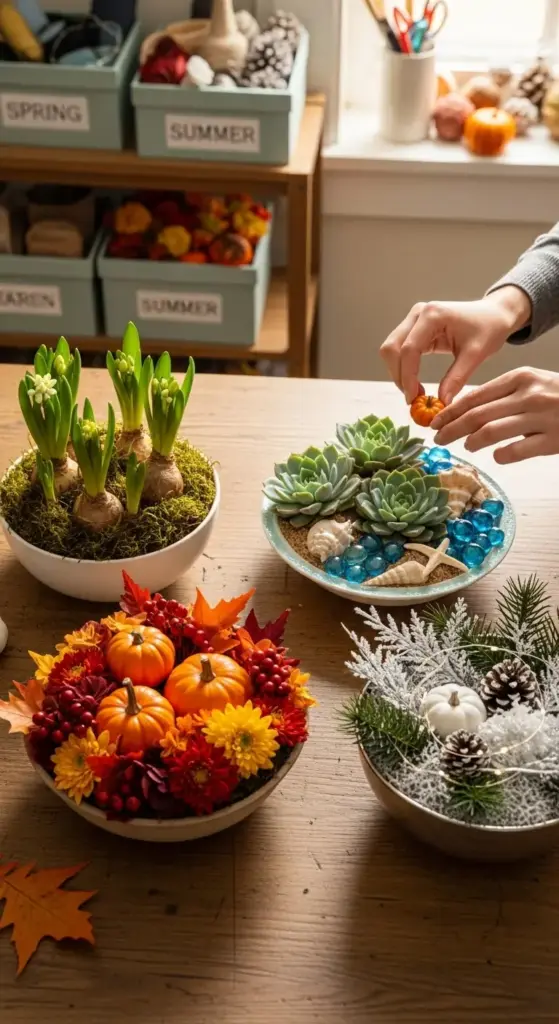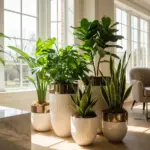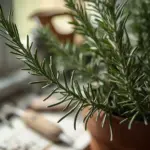7. The Seasonal Holiday Display

I used to be that person who left Christmas decorations up until March because taking them down felt overwhelming. Sound familiar?
Then I discovered seasonal dish gardens and everything changed. Now I actually look forward to switching things up because I’ve got a system that makes it fun instead of stressful.
My first attempt was a disaster though – I tried to cram every holiday decoration I owned into one container. It looked like a craft store exploded.
Spring Arrangements That Actually Feel Fresh
Flowering bulbs are absolute magic for spring displays. I plant grape hyacinths and mini daffodils in small pots in January so they’re ready to bloom by March.
The trick is forcing bulbs indoors about 12-16 weeks before you want them to flower. I keep them in my garage where it’s cold but not freezing.
Pastel decorations can look juvenile if you’re not careful. I stick to soft yellows and pale greens rather than Easter egg brights.
Moss creates the perfect spring base – it looks like new grass and stays green for months with minimal care. I collect it from my yard after rainy days.
Miniature flowering plants like primrose and small pansies add authentic spring color. They’re way more convincing than fake flowers and last for weeks.
Baby’s breath (the real stuff, not silk) creates this dreamy, cloud-like effect that screams spring romance. It dries beautifully too, so you get weeks of use.
Pastel river rocks in soft pinks and yellows tie everything together without looking too Easter-y. I found mine at a garden center for under ten dollars.
Summer Displays That Capture Vacation Vibes
Bright annuals are perfect for summer because they’re meant to be temporary. Impatiens and small begonias thrive in containers and bloom all season.
Beach themes transport you instantly, even if you’re stuck in the city. I use white sand, seashells, and pieces of driftwood I’ve collected over the years.
Succulents work amazingly for summer displays because they handle heat and look modern. Echeveria varieties come in gorgeous blue-greens that mimic ocean colors.
Miniature beach chairs made from popsicle sticks add whimsy without looking childish. I make them during rainy weekends and store them for summer swaps.
Colored glass gems in blues and turquoise create perfect “water” effects. They catch light beautifully and don’t fade like some decorations do.
Air plants tucked into shells or driftwood pieces add texture and movement. Spanish moss draped carefully creates that coastal atmosphere.
Fall Creations That Feel Genuinely Cozy
Miniature pumpkins are obviously essential, but the key is choosing the right varieties. Jack Be Little pumpkins stay tiny and last for months.
Autumn foliage needs to be preserved properly or it turns brown and crispy within days. I press leaves between wax paper and heavy books for at least a week.
Mums in small pots bring authentic fall color that lasts way longer than cut flowers. The button mums stay perfectly proportioned for dish gardens.
Pinecones collected from walks add natural texture and that perfect fall scent. I bake them at 200°F for 30 minutes to kill any bugs – learned this the hard way.
Cinnamon sticks bundled with raffia create instant fall ambiance and smell amazing. They last for years if stored properly between seasons.
Acorns and small gourds scattered throughout tie everything together. I collect these during October walks and they store beautifully in a cool, dry place.
Warm-toned stones in oranges, reds, and browns replace the bright summer colors. These create continuity while shifting the seasonal mood.
Winter Wonderlands That Actually Sparkle
Evergreens are the backbone of winter displays. Small spruce or pine cuttings from Christmas tree lots work perfectly and smell incredible.
Metallic accents catch winter light beautifully. I use silver spray paint on pinecones and small branches for that frosted effect.
White sand creates convincing snow that won’t melt or get moldy. I mix in a tiny bit of iridescent glitter for subtle sparkle.
Battery-operated LED lights transform winter displays into magical wonderlands. The warm white ones feel cozy, while cool white creates that crisp winter feeling.
Miniature evergreen trees made from bottle brushes look surprisingly realistic when dusted with artificial snow. I found mine at craft stores for under five dollars each.
Silver and white decorations keep things elegant rather than overwhelming. Small mercury glass ornaments catch light without looking too Christmas-y.
Frosted branches created with Epsom salt and water look like real ice crystals. This technique works on any bare branches and lasts for weeks.
Storage and Transition Tips That Save Your Sanity
Clear storage containers labeled by season are absolutely essential. I can see everything at a glance and nothing gets forgotten in the back of closets.
Photograph your displays before taking them apart. This saves so much time when you’re recreating them next year and can’t remember exactly how things looked.
Tissue paper prevents delicate decorations from breaking during storage. I wrap each piece individually – it takes extra time but saves money replacing broken items.
Transition gradually rather than completely starting over. I keep the base plants and containers, just swapping out seasonal decorations.
Natural elements like pinecones and shells can be reused year after year if stored properly. Keep them in breathable containers, not plastic bags.
Schedule seasonal swaps on your calendar. I do mine the first weekend of each new season, and it’s become a ritual I actually look forward to.
Base containers in neutral colors work for every season. White, natural wood, or soft gray planters adapt to any decorative theme.
Keep a seasonal decoration box with basics like colored sand, small figurines, and battery-operated lights. Having these staples ready makes transitions so much easier.
Plant rotation keeps displays fresh without constant replanting. I move seasonal plants to other spots in my house rather than throwing them away.
Document what works in a simple notebook. I write down which combinations looked best and which decorations held up well for future reference.
The key to successful seasonal displays is planning ahead and keeping things simple. Don’t try to recreate Pinterest perfection – focus on what brings you joy and fits your actual lifestyle.
Conclusion
These seven insider dish garden ideas prove that you don’t need a sprawling backyard to create stunning botanical displays!
Each design offers a unique way to express your personal style while bringing the calming benefits of nature into your busy life.
Start with just one design that speaks to your aesthetic – maybe the herb garden for your kitchen renovation or the zen garden for your home office. Remember, the best dish garden is one that brings you joy every time you see it!
Ready to transform your space? Grab your favorite container this weekend and let your creativity bloom. Your Instagram followers (and dinner guests) will thank you!









GIPHY App Key not set. Please check settings